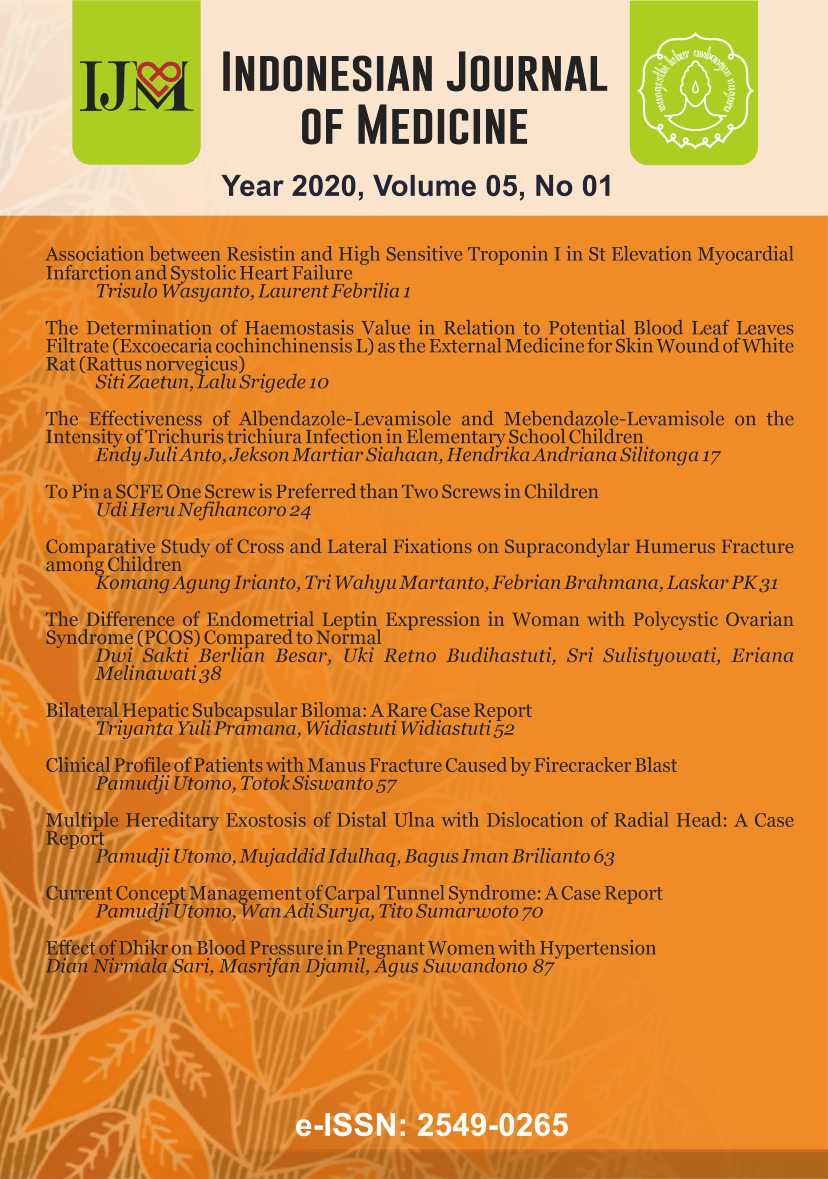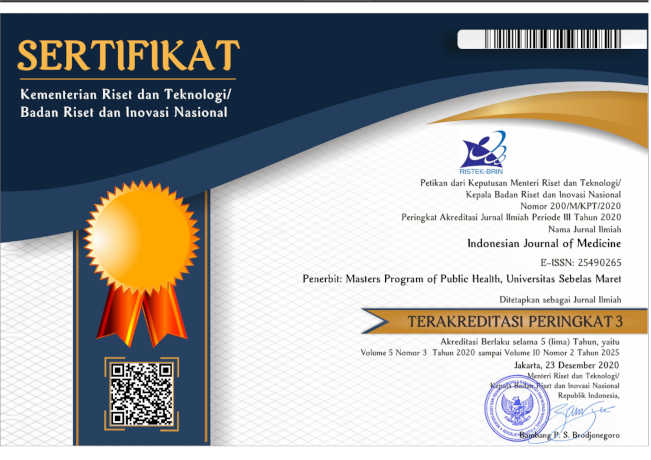Bilateral Hepatic Subcapsular Biloma: A Rare Case Report
DOI:
https://doi.org/10.26911/theijmed.2020.5.1.267Abstract
Background: Biloma is loculated collection of bile that may develop due to iatrogenic causes, traumatically or spontaneously with biliary tree disruption. Hepatic bilateral subcapsular biloma is a rare complication of laparoscopic cholecystectomy and an even more scarce when it occurs spontaneously.
Case Presentation: A 65 years old man came to our hospital with abdominal pain and en-larged abdomen. Six weeks earlier he underwent laparoscopic cholecystectomy in a private hospital, because of stone in the gall bladder and cholecystitis. The physical examination obtained no icteric and distended abdomen with pain on palpation. Laboratory findings were within normal limit with negative viral infection markers. Abdominal ultrasonography revealed chronic liver disease with giant liver cyst and ascites. Contrast abdominal multi-slice computed monography (MSCT) demonstrated bilateral hepatic subcapsular biloma. Laparatomy and drainage were then performed and he was discharged from the hospital several days later in good condition.
Discussion: Biloma was first introduced by Gould and Patel in 1979. The incidence of past laparoscopic cholecystectomy biloma is very low, between 0.6% and 1.5%. Early accurate diagnosis is very important to determine the proper management. In our case, the biloma was found by using USG and MSCT. Usually it presents with right upper quadrant or epigastric pain, abdominal distention, fever and leukocytosis, but our patient did not have either fever or leukocytosis. Actually the first treatment choice is percutaneous catheter drainage but in our case laparotomy drainage was performed because of subcapsular, biloma in both right and left hepatic lobes.
Conclusion: Bilateral hepatic subcapsular biloma is a rare case. One of its diagnostic tools is MSCT. Biloma drainage is the first choice of treatment.
Keywords: Biloma, post laparoscopic cholecystectomy, drainage
Correspondence:
Triyanta Yuli Pramana. Department of Gastroenterology and Hepatology Division, Dr. Moewardi Hospital/ Faculty of Medicine, Universitas Sebelas Maret. Email: typramana@gmail.com
Indonesian Journal of Medicine (2020), 05(01): 52-56
https://doi.org/10.26911/theijmed.2020.05.01.08
References
Braithwaite BM, Cabanilla LT, Lilly M (2003). Hepatic subcapsular biloma:A rare complication of laparoscopic cholecystectomy and common bile duct exploration. Curr Probl Surg, 60(2): 196–198. https://doi.org/10.1016/S01497944(02)007389
Brown S, Giuseppucci P, Esper C (2017). Rare reported left hepatic subcapsular biloma and management. Case Rep Surg, 1–3. https://doi.org/10.1155/2017/8609185.
Dupas JL, Mancheron H, Sevenet F, Delamarre J, Delcenserie R, Capron JP (2016). Hepatic subcapsular biloma. Gastroenterology, 94(5): 1225–1227. https://doi.org/10.1016/00165085(88)90017-0
Sakamoto I, Iwanaga S, Nagaoki K, Matsuoka Y, Ashizawa K, Uetani M, Fukuda T, Okimoto T, Okudaira S, Omagari K, Hayashi K, Matsunaga N (2003). Intrahepatic biloma formation (bile duct necrosis) after transcatheter arterial chemoembolization. AJR Am J Roentgenol. 181(1): 79-87. https://doi.org/10.2214/ajr.181.1.1810079
Kuligowska E, Schlesinger A, Miller KB, Lee VW, Grosso D (1983). Bilomas: A new approach to the diagnosis and treatment. Gastrointest Radiol,8(1): 237–243. https://doi.org/10.1007/BF01948126
Lebensburger J, Esbenshade A, Blakely M, Wang W, Hankins J (2008). Biloma and pneumobilia in sickle cell disease. Pediatr Blood Cancer, 51: 288–290. https://doi.org/10.1002/pbc.
Okello TR, Ocen D, Okello J, Pecorella I, Amone D (2018). Case report: Biloma gastrostomy after failed sonogramguided percutaneous aspiration, pigtail catheter insertion and surgical drainage. AAS Open Research, 1: 19. https://doi.org/10.12688/aasopenres.12876.1
Peng CZ, Wang CY (2017). Giant intrahepatic biloma following blunt hepatic injury. Can J Emerg Med Care, 19(1): 61–62. https://doi.org/10.1017/cem.2015.106
Piraka C, Shah RJ, Fukami N, Chathadi KV, Chen YK (2009). EUS guided transesophageal, transgastric, and transcolonic drainage of intraabdominal fluid collections and abscesses. Gastrointest Endosc, 70(4): 786–792. https://doi.org/10.1016/j.gie.2009.04.049.
Shankar S, VanSonnenberg E, Silverman SG, Tuncali K, Morrison PR (2003). Diagnosis and treatment of intrahepatic biloma complicating radiofrequency ablation of hepatic metastases. AJR Am J Roentgenol, 181(2): 475–477. https://doi.org/10.2214/ajr.181.2.1810475
Solomon SB, Griffin JF, Weiss MJ, Boas FE (2016). Postoperative complications requiring intervention: Diagnosis and management. In Blumgart’s Surgery of the Liver, Biliary Tract and Pancreas: Sixth Edition, 1(2) : 27. https://doi.org10.1016/B978-0-323-34062-5.00027-3
Stathopoulos V, Georganas M, Stratakis K, Delaporta E, Karallas E, Koutsopoulos K (2014). Case report hepatic subcapsular biloma: A Rare Complication of Laparoscopic Cholecystectomy. Case Rep Surg. 3–6. https://doi.org/10.1155/2014/186819
Tamura N, Ishihara S, Kuriyama A, Watanabe S, Suzuki K (2015). Longterm follow up after non operative management of biloma due to blunt liver injury. World J Surg Oncol, 39(1): 179–183. https://doi.org/10.1007/s002680142780z
Tana C (2013). Sonographic assessment of a suspected biloma: A case report and review of the literature. World J Radiol, 5(5): 220. https://doi.org/10.4329/wjr.v5.i5.220.











